The Giant Isopod: A Fascinating Example of Gigantism in the Deep Sea

The giant isopod (Bathynomus giganteus) serves as a remarkable example of adaptation in Earth’s oceans. These fascinating creatures, with their massive size and unique characteristics, bear a resemblance to their smaller land relatives, the woodlouse. Found in the deep sea, they have captured the curiosity of marine biologists and deep-sea enthusiasts alike. The phenomenon of deep-sea gigantism, exemplified by these isopods, is a subject of ongoing scientific interest.
Reaching lengths of up to 16 inches (40 centimeters), these isopods are significantly larger than their shallow-water cousins. This size has likely evolved due to the extreme conditions of the deep sea, including high pressure, near-freezing temperatures, and scarce food resources. Giant isopods have adapted to these challenges with a slow metabolism that allows them to survive for extended periods without feeding.
Their large size may also help them cover more ground in their food-scarce environment. These crustaceans rely on a robust exoskeleton made of calcium carbonate, which provides protection against the immense pressure of the deep sea while allowing for flexibility. Giant isopods also possess specialized eyes capable of detecting the faintest light in the dark depths, which is essential for locating prey and potential mates.
The giant isopod’s life in the deep ocean demonstrates the remarkable adaptability of life to extreme environments, and research into these creatures provides valuable insights into the evolutionary processes that shape life in the most challenging habitats on Earth.
The Dumbo Octopus: A Unique Wonder of the Deep Ocean

The Dumbo octopus, belonging to the genus Grimpoteuthis, is a fascinating deep-sea cephalopod. Named after the Disney character for its distinctive ear-like fins, this octopus is a marvel of adaptation. Inhabiting the deep ocean at depths exceeding 22,000 feet (6,700 meters), the Dumbo octopus thrives in one of the harshest environments on Earth.
Unlike other octopus species, Dumbo octopuses lack a hard internal shell, allowing them to maintain flexibility in the face of the immense pressure of the deep sea. Their gelatinous bodies help them withstand this pressure while remaining agile. The most striking feature of these octopuses is their ear-like fins, which allow them to move through the water with impressive efficiency. These fins also help stabilize the octopus and steer it through unpredictable deep-sea currents.
Their specialized fins, coupled with their energy-efficient movement, enable them to conserve energy in an environment where food is limited and scattered. With large, highly sensitive eyes, Dumbo octopuses can detect even the faintest bioluminescence, aiding them in navigating and hunting in total darkness.
The Dumbo octopus feeds on small invertebrates such as crustaceans and worms. Its arms are equipped with highly sensitive suction cups that not only capture prey but also “taste” its environment, enhancing its ability to find food. This cephalopod’s extraordinary survival strategies highlight the adaptability of life in the deep sea and continue to intrigue scientists. As research into these creatures progresses, the Dumbo octopus offers valuable insights into deep-sea ecology and the development of adaptive traits in extreme environments.
The Faceless Cusk: A Rediscovered Mystery of the Deep Sea

The Faceless Cusk (Typhlonus nasus) is a unique fish that has piqued the interest of marine scientists since its rediscovery in 2017, nearly 150 years after it was first observed during the HMS Challenger expedition. This elusive fish, with its strange and featureless head, has sparked curiosity about deep-sea life.
The most notable characteristic of the Faceless Cusk is its seemingly blank face, with its tiny, recessed eyes, simple nostrils, and downturned mouth. While its appearance may seem otherworldly, this fish is not an eel but a true bony fish, closely related to the equally mysterious pearlfish.
Found at depths of 4,000 to 5,000 meters, the Faceless Cusk inhabits an environment of extreme cold, high pressure, and total darkness. These conditions have led to a series of fascinating adaptations. For instance, while the fish’s eyes appear absent, they are actually small and embedded beneath a transparent layer of skin. This suggests that the Faceless Cusk may still be capable of sensing light, which could help it detect bioluminescence in the dark waters.
Its nostrils, resembling eyes, are specialized for detecting chemical signals in the water, compensating for its limited visual capacity. These adaptations allow the Faceless Cusk to search for food and mates in the depths. The fish’s diet is largely unknown but likely consists of small invertebrates and detritus found on the ocean floor.
The rediscovery of the Faceless Cusk highlights the vast unknowns of deep-sea ecosystems and encourages further exploration of the depths. The unique adaptations of this fish underscore the incredible diversity of life that thrives in extreme conditions and offer new insights into the evolutionary processes that shape life in the deep ocean.
The Fearsome Pacific Black Dragon: Master of the Deep Sea
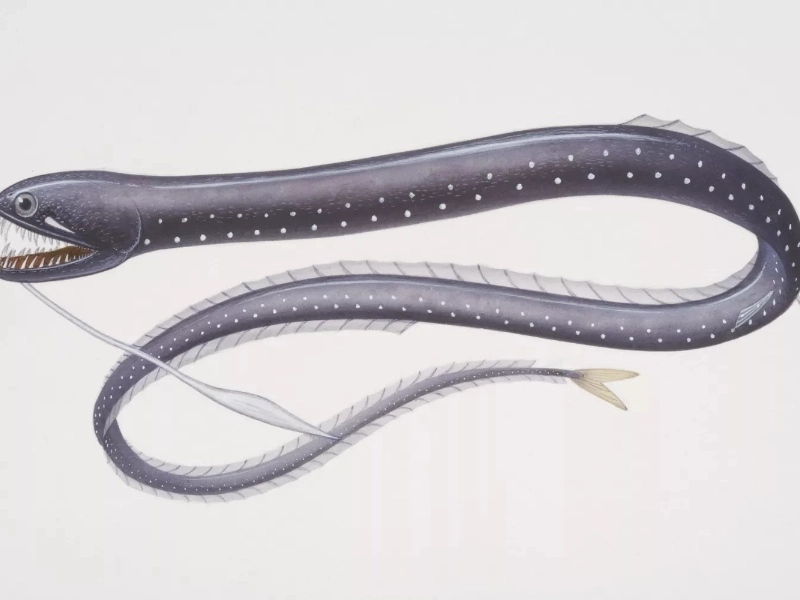
The Pacific Black Dragon (Idiacanthus antrostomus) is one of the most formidable and specialized predators of the deep sea, perfectly adapted to life in the harsh, lightless depths. With a body that is almost completely black, female Pacific Black Dragons are particularly suited for stealth, making them nearly invisible in the inky darkness of their environment. A distinctive feature of this species is a glowing barbel that hangs from the chin, acting as a lure to attract unsuspecting prey. This remarkable hunting tool is critical in an ecosystem where food is scarce, enabling the dragon to lure and capture its meals efficiently.
Sexual dimorphism is clearly evident in this species, as males are much smaller and simpler in structure than females. While the females are equipped for predation, males live primarily for reproduction. They are so specialized that their role is limited to fertilizing eggs and surviving off the female’s blood. This unique adaptation in the reproductive strategy is a key example of how deep-sea creatures have evolved to survive in a challenging environment, where conserving energy and ensuring reproduction are vital for the species’ survival.
The bioluminescent lure of the female is not just for show; it’s a sophisticated evolutionary feature that allows the dragon to adjust the light’s intensity and frequency, luring prey within reach. This helps the predator deliver a swift attack when the prey is close enough. Additionally, the Pacific Black Dragon’s large, sensitive eyes are adapted to detect the faintest glimmers of light in the dark, enhancing their ability to locate prey.
The Pacific Black Dragon’s reproductive strategy further highlights its specialized adaptations. Males, small and designed to detect pheromones, latch onto the females, ensuring a constant source of fertilization. This parasitic reproductive behavior is a striking example of how species in the deep sea have evolved to optimize survival and reproduction under extreme conditions. Scientists continue to study this species’ life cycle and adaptations, which offer valuable insights into the evolutionary mechanisms shaping marine life.
The Mysterious White Squid: Unlocking Deep-Sea Secrets

The Ramshorn Squid (Spirula spirula), a small cephalopod that measures less than seven centimeters, is one of the ocean’s most enigmatic creatures. It is known for its internal spiral shell, which is a buoyancy organ made of calcium carbonate. This unique shell allows the squid to maintain its position in the water column with minimal energy, making it an effective survivor in the deep sea.
For decades, marine scientists had little information about the squid’s natural behaviors due to its rare sightings. However, a breakthrough came in 2020 when scientists captured footage of the squid in its natural habitat for the first time. The video revealed that the squid orients itself in a head-down position, which challenges previous assumptions about how these creatures interact with their environment.
The squid’s ability to control its buoyancy allows it to migrate vertically between depths to find food and avoid predators. Its diet, once thought to consist mainly of small crustaceans and fish, has been found to be more diverse. The squid’s ability to ambush prey from below, using its arms to gather small animals that drift upward from shallower waters, showcases its adaptability and energy-efficient feeding methods.
The squid’s internal shell, which provides buoyancy control, has inspired interest in material science and engineering, particularly in the development of autonomous underwater vehicles. This creature’s ability to navigate the deep sea with minimal energy usage holds valuable lessons for improving technology that explores these extreme environments. Further research on the Ramshorn Squid will continue to shed light on the deep-sea ecosystem and its inhabitants.
Giant Spider Crab: A Colossal Deep-Sea Survivor
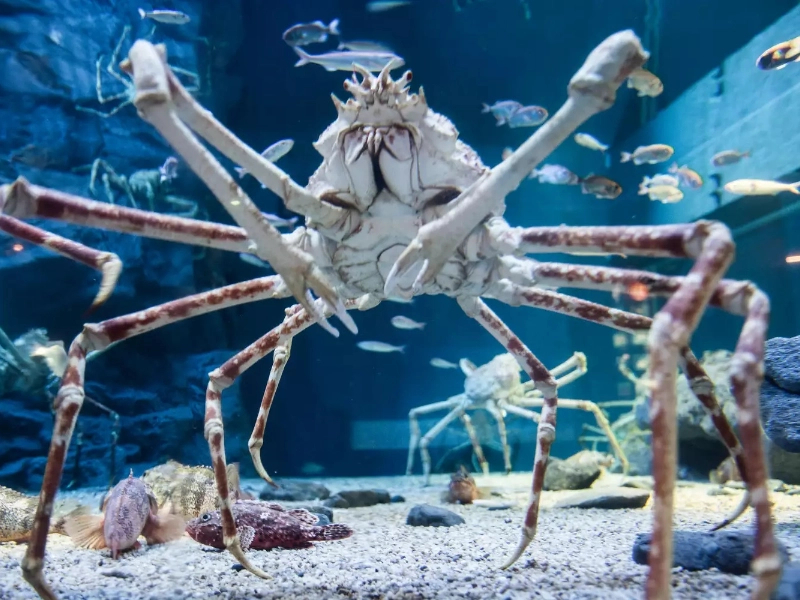
The Giant Spider Crab (Macrocheira kaempferi) is one of the most awe-inspiring creatures of the deep ocean, renowned for its enormous size and distinctive appearance. Native to the waters around Japan, this giant crustacean is the largest known arthropod, with a leg span of up to 12 feet (3.7 meters). Found at depths ranging from 150 to 800 meters, it thrives in the cold, dark waters of the deep sea.
The spider crab’s large size is an adaptation to its high-pressure, low-food environment, allowing it to cover vast areas of the ocean floor in search of sustenance. Its long, slender legs help it move with minimal energy, and its armored exoskeleton offers protection from predators. Additionally, it can camouflage by attaching various marine organisms to its shell, such as sponges and algae, to blend in with its surroundings.
Although its appearance may seem intimidating, the spider crab is a scavenger, feeding primarily on carrion and small marine organisms. It plays a crucial role in the ecosystem by helping break down organic matter. The species’ life cycle is notably slow, with individuals living up to 100 years. Females can carry up to 1.5 million eggs, and the larvae go through several developmental stages before maturing into crabs.
Due to its slow growth and cultural importance, particularly in Japanese cuisine, conservation efforts are underway to protect the spider crab’s population. Marine protected areas and fishing restrictions are being implemented to ensure the species’ long-term survival. As scientific research continues, the study of the spider crab offers important insights into deep-sea ecology and the evolutionary adaptations of marine life.
Armored Sea Robin: A Deep-Sea Marvel
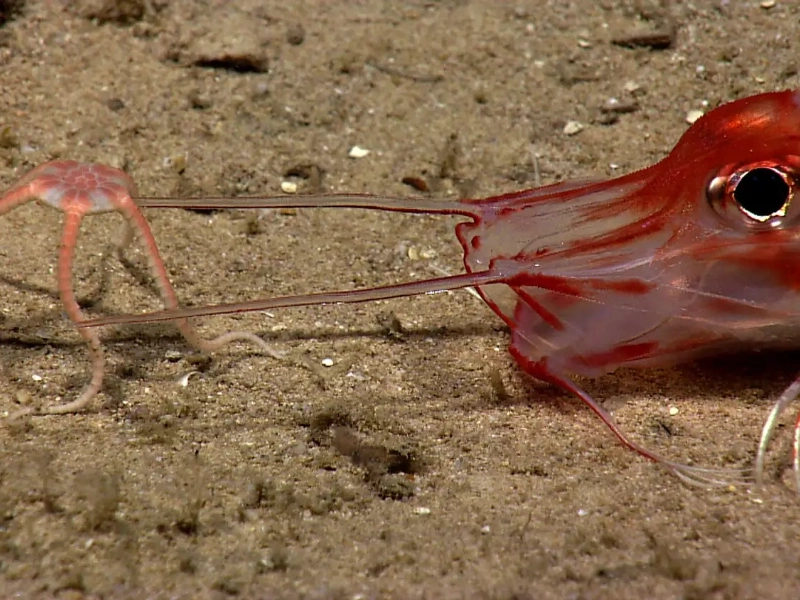
The Armored Sea Robin is an extraordinary fish that has adapted to survive in the deep-sea environment. Typically found at depths of 100 to 500 meters, this fish has evolved a number of specialized features that help it thrive in the harsh conditions of the deep ocean. One of its most notable traits is its bony, armored body, which provides protection from predators and the immense pressure of the deep sea.
In addition to its armor, the Armored Sea Robin has a unique way of moving. Unlike most fish, it uses its pectoral fins as “legs,” walking along the ocean floor in search of food. This adaptation allows it to forage more effectively and escape threats with precision. The fish’s flattened body shape helps it remain stable in the ocean currents, further aiding in its survival.
This species primarily feeds on small benthic invertebrates such as crustaceans and mollusks, using its sensitive barbels to sift through the mud and locate food. The Armored Sea Robin’s remarkable mobility and feeding strategies have made it an interesting subject of study for marine biologists.
The transformation of the fish’s pectoral fins into walking appendages is a fascinating example of evolutionary adaptation. This unique feature offers insights into how early vertebrates may have transitioned from water to land. Ongoing research into the Armored Sea Robin continues to expand our understanding of deep-sea organisms and their complex interactions within the ecosystem.
Honeybee Sharks: Living Fossils from the Deep
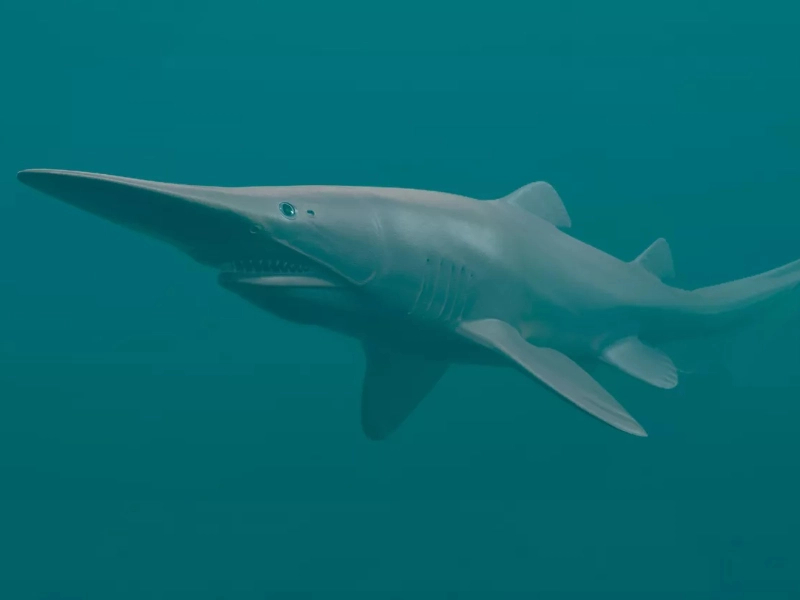
The Mitsukurina owstoni, often called the “living fossil,” is one of the most unique and intriguing deep-sea creatures. This rare species belongs to the Mitsukuridae family and is the only surviving member of a lineage that dates back over 125 million years. The Mitsukurina owstoni is known for its unusual body structure and specialized hunting technique, which has garnered significant interest from both the public and the scientific community. Its distinctive long, flat snout, often referred to as the “snout,” extends far beyond its mouth and is a key feature of its appearance. The snout is equipped with specialized sensory organs, called the ampullae of Lorenzini, which help the shark detect weak electric fields emitted by potential prey in the pitch-black depths of the ocean. This sensory adaptation enables the shark to survive in an environment with little or no visual cues.
The shark’s protruding jaws are another remarkable feature. These jaws can extend rapidly from the corners of its mouth, using suction to pull in prey. This unique jaw mechanism is supported by a system of ligaments and cartilage that allows the jaws to move swiftly. Typically found at depths between 270 and 960 meters, Mitsukurina owstoni can also be found as deep as 1,300 meters. Its soft, pinkish-grey body would likely appear red in its natural habitat due to the filtering of light at extreme depths, providing effective camouflage. The shark’s small eyes further suggest it relies on senses other than vision.
Despite its fearsome appearance, the Mitsukurina owstoni is a slow-moving predator that uses ambush tactics to capture its prey. It primarily feeds on crustaceans, cephalopods, and bony fishes. The shark’s ability to find and capture prey in total darkness highlights its highly developed sensory and dietary adaptations. Due to their rarity and the challenges of studying deep-sea creatures, much is still unknown about the reproductive habits of the Mitsukurina owstoni. It is believed to be ovoviviparous, meaning the eggs hatch inside the female’s body, but further research is required to understand its reproductive cycle fully.
The rarity of the Mitsukurina owstoni and its deep-sea habitat make conservation efforts difficult. Although it is not directly targeted by commercial fishing, it may be caught incidentally in deep-sea trawl nets. The potential impact of such bycatch on Mitsukurina owstoni populations remains unclear, emphasizing the need for more research and conservation strategies. As we continue to explore the depths of the ocean, the Mitsukurina owstoni serves as a reminder of the incredible adaptability and diversity of life in Earth’s least explored environments.
Sea Pig: Mysterious Wanderer of the Abyssal Plain

The sea pig, scientifically known as Scotoplanes globosa, is a fascinating member of the Holothurian family, more commonly known as sea cucumbers. Despite its pig-like name, this deep-sea creature bears little resemblance to its terrestrial counterparts. Its quirky appearance has drawn the attention of both the general public and deep-sea researchers. Found at depths of over 1,000 meters, sea pigs inhabit the abyssal plains of oceans across the world and play a crucial role in the deep-sea ecosystem.
The sea pig’s most notable feature is its translucent, pinkish body, which can stretch up to 15 centimeters. Its gelatinous body is supported by an internal calcium carbonate skeleton, allowing it to remain both rigid and flexible in the deep-sea environment. This transparency helps the sea pig blend into its surroundings, providing protection from predators. Its body is equipped with numerous tube feet, which it uses to glide across the ocean floor in search of food. These tube feet also leave distinctive tracks in the sediment, which can be seen in deep-sea images.
As sediment feeders, sea pigs consume organic material that settles on the ocean floor, such as decomposed plant and animal matter known as marine snow. This feeding behavior helps recycle nutrients and maintain the health of deep-sea ecosystems. Sea pigs are also known to gather in large groups, sometimes numbering in the hundreds, which may occur in response to a particularly rich food source, such as a whale carcass.
The reproductive behavior of sea pigs is still not well understood, but they are believed to reproduce sexually by releasing eggs and sperm into the water column, where fertilization occurs. The larvae eventually settle on the sea floor, where they develop into adult sea pigs. Despite the challenges of studying these creatures, scientists are keenly interested in their role in the deep-sea food web and their potential as indicator species for the health of deep-sea ecosystems.
As deep-sea mining and other resource extraction projects gain attention, questions arise about their potential impacts on species like the sea pig. In addition, sea pigs’ regenerative abilities have sparked interest in biomedicine, as they may provide insights into developing new regenerative treatments. The sea pig is a prime example of the diverse and adaptive life forms that inhabit the deep ocean, highlighting the need for continued research and conservation efforts to protect these unique ecosystems.
Blob Sculpin: Grotesque Wonders of the Deep
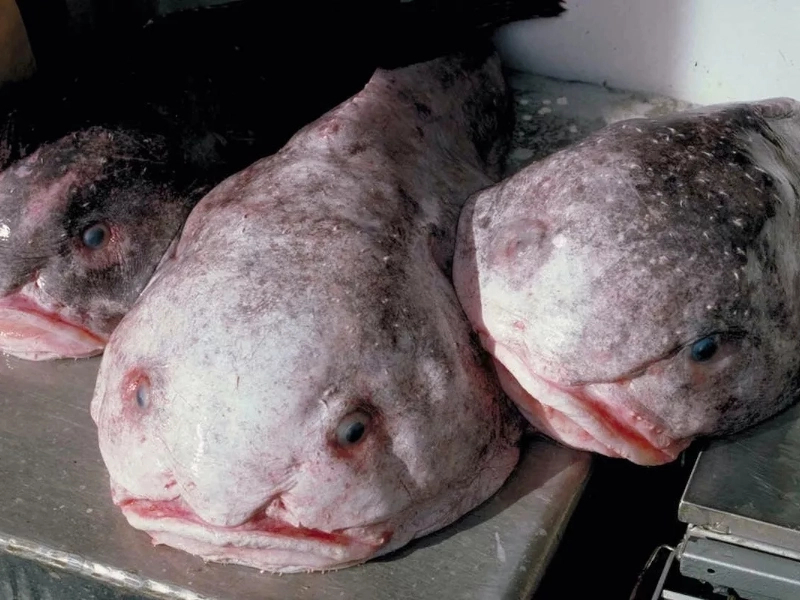
The Blob Sculpin, also known as Psychrolutes phrictus, is a deep-sea fish found in the cold waters of the North Pacific Ocean, ranging from the Bering Sea to Southern California. Living at depths between 100 meters and 2,800 meters, the Blob Sculpin has developed a range of adaptations to survive the extreme conditions of the deep sea. Its unusual appearance, with a soft, gelatinous body, has captivated both the public and scientific communities.
The Blob Sculpin’s body is particularly unique. When brought to the surface, the sudden change in pressure causes its gelatinous body to lose its shape, giving it a “melting” appearance. However, in its natural deep-sea habitat, where pressures can reach up to 100 atmospheres, the Blob Sculpin retains a more regular form. This soft body composition is an essential adaptation that allows the fish to survive without a gas-filled swim bladder, which would collapse under such extreme pressure. The Blob Sculpin grows to a length of around 60 centimeters, with its large head making up about half of its total body length.
Due to the perpetual darkness of its deep-sea environment, the Blob Sculpin has relatively small eyes. Instead, it relies on other sensory adaptations, such as its lateral line system, to detect vibrations and movements in the water. The Blob Sculpin’s primary food sources are small invertebrates found on or near the ocean floor. Its large mouth and protruding mandibles allow it to scoop up prey such as mollusks, sea anemones, and crustaceans. Although slow-moving, the Blob Sculpin is an effective ambush predator, using its camouflage and patience to capture unsuspecting prey.
Research into the Blob Sculpin’s reproduction is ongoing, but observations suggest that the female lays large numbers of eggs near rocky areas or hydrothermal vents. Interestingly, male Blob Sculpins have been observed guarding these egg masses, a behavior not commonly seen in deep-sea fish. This parental care could make the Blob Sculpin more vulnerable to environmental changes, such as overfishing.
Despite its somewhat eerie appearance, the Blob Sculpin plays an important role in deep-sea ecosystems. Its unique adaptations offer valuable insights into how life survives in the extreme conditions of the deep ocean. Additionally, the Blob Sculpin has drawn attention to the need for conservation efforts in deep-sea environments, as human activities, such as deep-sea trawling, may have unintended consequences for these vulnerable populations. As our understanding of the deep sea continues to grow, the Blob Sculpin serves as a reminder of the remarkable diversity of life in Earth’s most remote ecosystems.
Amanita: A Ribbon-Like Predator of the Ocean Floor

Proboscis worms, also known as ribbon worms or nemertean worms, are fascinating marine invertebrates found in a variety of marine environments worldwide, from shallow coastal waters to deep sea abyssal plains. These creatures can grow as long as 6.5 feet (2 meters), and though they are often overlooked, they play an important role in marine ecosystems. The proboscis worm gets its name from its most distinctive feature – the proboscis. This muscular, elastic organ extends from a depression above the intestine and can rapidly invert. When fully extended, it can be as long as the worm’s body. The proboscis serves as both a sensory organ and a tool for capturing prey. It typically contains venom that allows the worm to immobilize prey much larger than itself, making it an efficient predator despite its soft body. Proboscis worms exhibit considerable diversity in size, color, and environmental preferences, ranging from small species to ones that grow to the size of the largest invertebrates. Their colors vary from dull browns and grays to more vibrant hues like reds, greens, and purples. Some species are free-swimming, while others burrow into sediments or form symbiotic relationships with other organisms. Proboscis worms are opportunistic feeders, with many preying on small invertebrates like mollusks, crabs, and even other worms. Larger species may even capture fish. The worms have evolved to feed on whatever organic matter they can find in the deep ocean, including carrion. One of the most remarkable features of proboscis worms is their regenerative ability. Many species can rebuild parts of their body if damaged or fragmented, with some using this ability as a form of asexual reproduction. The regeneration process allows each half of a bisected worm to regrow into a complete individual. This ability has captured the interest of regenerative biology researchers, as it could have implications for tissue regeneration and wound healing in humans. Reproduction in proboscis worms is generally sexual, though some species reproduce asexually. Some species are hermaphroditic, meaning they have both male and female reproductive organs, and fertilization can be internal or external depending on the species. Many species exhibit parental care, with females guarding egg masses until they hatch. Proboscis worms are an essential part of marine ecosystems, regulating populations of various marine invertebrates and contributing to the balance of benthic communities. Their burrowing activity helps with nutrient cycling and oxygenating the seafloor, a process known as bioturbation. Furthermore, research into the venom of proboscis worms and the unique process of proboscis reversal has inspired innovations in pharmacology and robotics. In the face of challenges like habitat degradation, pollution, and climate change, proboscis worms are at risk, especially those living in deep-sea environments. Continued research and conservation efforts are necessary to protect these unique creatures and the ecosystems they support.
Stonefish: Nature’s Deadly Masquerade
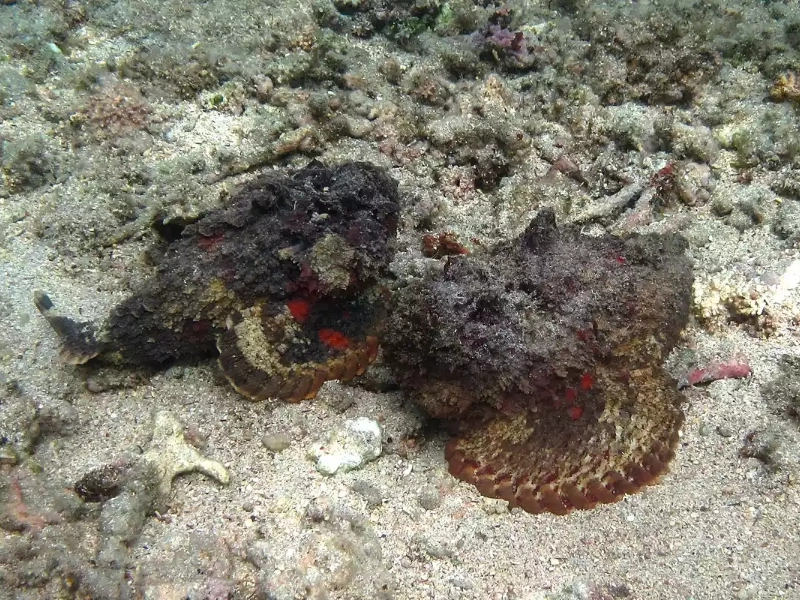
The stonefish (Synanceia) is a highly venomous fish found in the Indo-Pacific coastal regions, including Australia. Known for its incredible camouflage and potent defense mechanisms, the stonefish is a remarkable example of nature’s ingenuity. This species, which grows to 30-40 centimeters (12-16 inches) in length, is often overlooked due to its small size, but it plays a significant role in marine ecosystems and can pose serious risks to humans. The stonefish’s camouflage is one of its most remarkable features. Its body is covered with warty bumps and mottled coloring, mimicking the appearance of coral-encrusted rocks. This camouflage helps the stonefish blend seamlessly into its environment, making it nearly impossible to detect by both predators and prey. As an ambush predator, the stonefish lies in wait for unsuspecting prey to pass by, then strikes with impressive speed. The stonefish’s most notable defense is its venomous spines. It has 13 sharp dorsal spines, each connected to venom glands. When pressure is applied to these spines, the covering retracts, exposing the tips, which penetrate deeply and inject venom. This neurotoxic venom can cause intense pain, paralysis, and in extreme cases, death. A stonefish sting typically causes immediate and severe pain, along with symptoms such as edema, paralysis, and shock. If not treated quickly, the venom can be fatal within hours. Despite its dangerous defense mechanisms, the stonefish is not an aggressive predator. It uses its camouflage to patiently wait for prey, such as crustaceans and small fish, to come within range. The stonefish’s ambush hunting strategy, combined with its low swimming speed, makes it highly efficient in environments where food is scarce. Stonefish reproduction is external, with females releasing hundreds of eggs into the water, which are then fertilized by males. The fertilized eggs develop into planktonic larvae that eventually settle on the seafloor and transform into young stonefish. In marine ecosystems, stonefish help regulate populations of small fish and crustaceans, maintaining the balance of coral reef habitats. However, their venomous nature also influences the behavior of other marine organisms, as many predators avoid areas where stonefish are present. From a human perspective, the venom of the stonefish has both dangers and potential benefits. Antivenoms have been developed to treat stings, saving many lives. Researchers are also investigating the medical applications of stonefish venom, including potential treatments for cardiovascular diseases and pain management. However, the stonefish’s habitat faces threats from pollution, climate change, and coral reef destruction. Conservation efforts are essential to preserve both the stonefish and the marine ecosystems they inhabit. By increasing public awareness and understanding of these creatures, we can reduce the risk of human stings while also supporting the conservation of this unique species and its role in marine biodiversity. Stonefish are a reminder of the complexity and beauty of life beneath the ocean’s surface, where adaptation and survival strategies are often astonishingly effective
